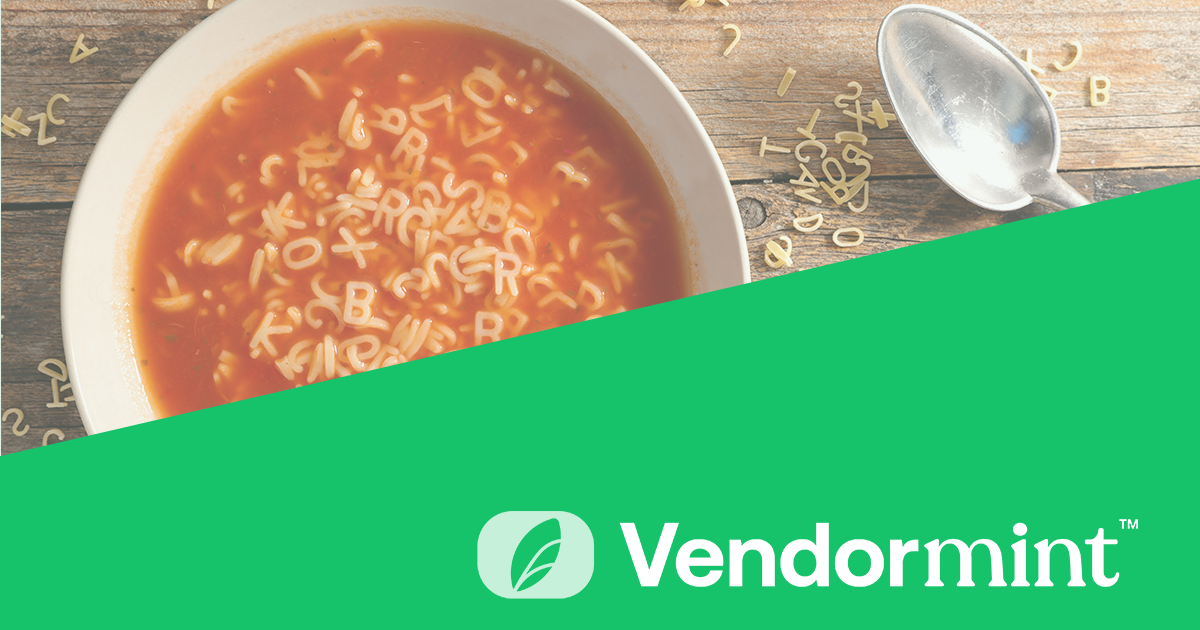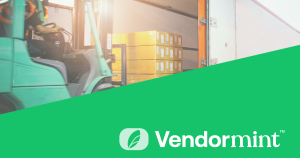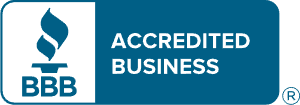Digesting the Supply Chain Alphabet Soup
ASN, BOL, EDI, SQEP, POD, ORAD, OTIF, OTFR, and more

As any retail supplier knows, the supply chain world is full of acronyms and abbreviations. We’re here to help you digest that alphabet soup.
There are four broad categories of glossary terms in supply chain management. These are:
- Compliance metrics and penalties (i.e., deductions, chargebacks, and accounts receivable fines)
- Documentation, labeling, and packaging
- Logistics and shipping
- Technology
This list is categorized and in alphabetical order. If you have a specific abbreviation you’re looking for, hit CMD+F on Mac or CTRL+F on Windows and type your inquiry.
Compliance Metrics and Penalties in Supply Chain
There is plenty to write about in the retail supplier world regarding compliance and deductions management, but here are the key terms and definitions.
COGS (Cost of Goods Sold)
COGS refers to some retailers’ penalties related to shipment timeliness or fill rate. For example, Target charges 3% of COGS for shipments that fail to comply with its OTFR program. You can calculate COGS with this formula:
(Beginning Inventory + Purchases) – Ending Inventory = COGS
KPI (Key Performance Indicator)
KPIs are retail metrics that indicate how well a supplier fulfills orders and maintains proper documentation, labeling, and packaging for its products. OTIF (also known as ORAD for Kroger and OTFR for Target) is a critical metric that retailers use to measure their suppliers’ success.
LOG Deductions (CVS logistics deductions)
LOG Deductions are CVS-specific chargebacks and fines due to both supplier and carrier non-compliance with its routing requirements or the handling of goods. These deductions are a part of CVS’s SCP programs and can get costly. (Luckily, you can recoup lost revenue if you dispute the deduction.)
MABD (Must Arrive By Date)
The MABD is a date and time on your purchase order that states when you must have your freight or shipment in a DC, FC, or store. Typically, these dates have padding before the retailer considers the shipment early or late. For example, Walmart considers some orders late if they arrive one to three days late, depending on the department.
MOQ (Minimum Order Quantity)
MOQ refers to the smallest number of units, case packs, or pallets, depending on the purchaser. Some retailers require a specific number of units from their suppliers to sell in-store. MOQ can also be a dollar amount per order.
OKR (Objectives and Key Results)
OKRs are metrics similar to KPIs. These indicators include fill rate, damages, timeliness, and other goals, such as EDI compliance or package labeling.
ORAD (Original Requested Arrival Date)
ORAD is specific to Kroger and is its chief compliance KPI. Orders must arrive in full by the date on the PO, or Kroger will impose costly fines on the supplier. This metric includes case fill rate, on-time compliance, and adherence to the scheduled delivery appointment at the DC or store.
OS&D (Overages, Shortages, and Damages)
OS&D is a type of retail deduction that can occur when too many, too few, or damaged items arrive at the DC or store. These deductions rely on signed PODs and BOLs to determine the quantity and quality of the shipment’s contents. Luckily, these chargebacks are relatively easy to prove invalid, provided you have the proper documentation.
OTFR (On Time Fill Rate)
OTFR is Target’s KPI for shipment timeliness and amount of product. If you are late or early, ship too much or too little, or otherwise fail to comply with this objective, you can receive costly COGS fines or other penalties, such as costs per carton for non-compliance with its ASN or barcode policies.
OTIF (On Time In Full)
Walmart first coined the term OTIF in 2017, and other retailers have taken up this OKR for their suppliers. While many OTIF requirements exist across different retailers (such as CVS, The Home Depot, Dollar General, and many more), most require shipments to arrive within a delivery window on the PO and at least 87-95% in full. OTIF non-compliance gets costly quickly, so optimizing your supply chain is vital.
RTV (Return to Vendor)
RTV refers to retailers like Macy’s and their right to return rejected or unordered items back to the retail supplier at the supplier’s expense. These are products that were not on the original EDI 850 PO. At Macy’s, its CRCs are responsible for preparing and packing returned items for the supplier to pick up.
SCP (Supply Chain Performance programs)
SCP programs are metrics that retailers like CVS use to ensure suppliers comply with logistics requirements, such as EDI, OTIF, and other OKRs. CVS is the largest pharmacy retailer in the United States, so it has a rigorous SCP program.
SQEP (Supplier Quality Excellence Program)
SQEP is Walmart’s new initiative to ensure supplier compliance. It involves packaging and labeling requirements, ASN and other EDI standards, logistics metrics (e.g., pallet stability), and much more. Walmart refers to SQEP non-compliance in terms of “defects” and gives many defect reasons. Luckily, these are disputable.
STA (Ship to Arrive date)
The STA date is a CVS requirement for suppliers’ BOLs. CVS puts this date on the POs it sends out to suppliers, and, in return, to avoid deductions, you must put the original STA on the signed bill of lading as “PO STA 04/04/25” (i.e., MM/DD/YY).
UL (Underwriters’ Laboratory) and UL WERCSmart®
UL is an international organization that provides testing and retail goods standards. Its WERCSmart® is an international registry of products that adhere to these regulatory compliance standards. For example, Macy’s has requirements about the durability of its clothes, such as fabric degradation.
Documentation, Labeling, and Packaging
Documentation is a vital link in the supply chain, and suppliers can use documents to dispute invalid deductions and chargebacks. Labeling and packaging are also critical and often KPIs for retail suppliers and their customers.
ASN (Advance Ship Notice or EDI 856)
The ASN is a vital document for combating invalid deductions and maintaining retailer compliance standards. Metrics like SQEP and OTFR from Walmart and Target require proper and timely transmission of the ASN. Defects and non-compliance can add up quickly and severely impact your bottom line, so make sure you choose the right EDI provider or 3PL. You can also use ASNs to fight these defects and other deductions to prove that you shipped the right amount of goods at the right time.
BB (Best By Date)
Often used in food items, the BB date is critical for retailers to maintain product integrity and customer satisfaction. Failure to add BBs to labels can cause chargebacks from Kroger and other retailers.
BOL or B/L (Bill of Lading)
BOLs are key, legally binding shipping documents used in supply chain management to indicate that the carrier will deliver the shipment as promised to the destination DC or store. BOLs are promises to the supplier that the goods will arrive undamaged and transfer product ownership to the carrier. You must use BOLs in deductions disputes, as well as PODs.
DUNS (Data Universal Numbering System)
In EDI documents and others, you must have a DUNS number assigned to you by Dun & Bradstreet. This number is unique to your supplier business and identifies you electronically across all platforms.
EAN (European Article Number), GTIN (Global Trade Item Number), and IAN (International Article Number)
EANs, GTINs, and IANs are unique numbers for your products required in your EDI documents, such as your ASNs. In the U.S., domestic goods use the 14-digit GTIN as the barcode. Some suppliers use a 12-digit GTIN as the UPC. EANs and IANs are the European and international versions of these numbers.
ECT (Edge Crush Test)
The ECT is a packaging requirement specifically relating to the durability of product packaging. Manufacturers measure ECT on boxes (usually corrugated cardboard) as pounds per inch on the load-bearing edge. This metric indicates how much weight a box can take when stacked in a warehouse or on a truck and, therefore, how to avoid damages.
EPC (Electronic Product Code)
The EPC is a unique product identifier based on GS1 Standards that RFID scanners use in warehouses and at DCs. Retailers like Walmart rely heavily on RFID scanners to maintain instocks and ensure products go to the right stores at the right time.
PO (Purchase Order)
A PO (also known as an EDI 850 PO or EDI 875 Grocery PO) is a request from your retailer to purchase goods and have them shipped to a specific location, such as a store (known as SWAS orders) or DC. Make sure you track these documents, as they can help prove you shipped correctly compared to a signed POD.
POD (Proof of Delivery)
Like the BOL, PODs are vital to disputing invalid OS&D deductions. A signed POD shows that the consignee received all of the products listed, properly counted them, and ensured their quality. If you receive an OS&D deduction, use this document and the PO to dispute it. BOLs are similar and just as helpful in deductions disputes.
REC (Received)
The REC code is specific to Dollar General POs. You must use this code to indicate and acknowledge in GOLD that you have received the purchase order and are consenting to ship the requested product by the requested date.
SKU (Store-Keeping Unit)
SKUs are ubiquitous in retail. They are not necessarily unique but are specific to a supplier’s or retailer’s business. SKUs are similar to UPCs, GTINs, and barcodes but can be any length and contain alphanumeric characters. They can indicate a product’s type, size, color, flavor, or any other variable, or they can be generic to all products of a particular type (e.g., women’s sweater as opposed to women’s medium-sized, blue and gray, cashmere wool sweater).
SSCC (Serial Shipping Container Code)
SSCC is an 18-digit code tracked on EDI documents that identifies packing units like pallets or master cartons. It’s embedded in GS1 labels and helps retailers track products through receipt at the DC and store delivery. If you don’t list the SSCC in your EDI for your shipment, you may see ASN defects and other deductions.
TC (Ticket Compliance)
TC refers to retailers’ requirements for proper product tagging and ticketing, especially in apparel and general merchandise. These include price tags, hang tags, or barcoded labels. You will see deductions or chargebacks from retailers like Macy’s, Nordstrom, and Belk for ticketing non-compliance.
UPC (Universal Product Code)
The UPC, also known as the GTIN-12, is used in EDI documents to indicate a product. It differs from the barcode number but may appear on the product tag or case pack, depending on the product type. The UPC is a unique identifier for the product.
Logistics and Shipping
Logistics and shipping are the lifeblood of supply chain management. Supply chains wouldn’t exist or be necessary without this aspect. How your carriers and 3PLs handle your product can profoundly impact your revenue and bottom line, particularly if there are non-compliance issues.
3PL (Third-party Logistics company)
Third-party logistics companies are a key component of the supply chain. While major suppliers such as Tyson Foods can afford to build their own logistics departments and teams, smaller suppliers use 3PLs to handle shipping, warehousing, EDI, and other logistics. 3PLs use TMS and WMS software and brokers to get the best pricing for their customers. If you use a 3PL, it’s essential to maintain a solid line of communication with them, particularly in times of trouble, such as EDI or OTIF non-compliance.
ATP (Available to Promise)
ATP is a real-time inventory calculation used in ERP, WMS, and retailer-specific order systems to determine how much stock is available for fulfillment. ATP helps you avoid backorders and supports more accurate supply commitments to your retailers.
COD (Cash on Delivery)
COD refers to payment once a shipment arrives at the DC or store. Collect suppliers use this method of shipping, which is also known as Collect on Delivery. For more information on Collect versus Prepaid, check out our post on choosing your shipping option.
CPU (Customer Pickup)
CPU is an acronym that some retailers use to refer to PPD shipments. These are the alternatives to COD or Collect shipments. They are beneficial in that there are no hidden costs involved.
DC (Distribution Center)
A DC is the central hub of a retailer’s stores in a region. When a store runs out of product inventory, it will order it from the DC. When the DC runs out of a product, the retailer will order it from you to ship to the DC. Local DCs help keep up instocks and aid replenishment.
DSD (Direct Store Delivery) or DTS (Direct to Store)
DSD or DTS refers to deliveries that skip the DC or FC and go straight to the store’s inventory. Suppliers that use their own distribution models, like Coca-Cola, use this method to replenish their stores. They have their own trucks, warehouses, and stockers.
FC (Fulfillment Center)
Omnichannel retailers and online-only stores like Amazon use FCs to distribute goods directly to the consumer. Walmart uses FCs for its Walmart+ same-day delivery, while the retailer uses DCs for distribution to its stores.
FOB (Free on Board)
FOB is the term that some retailers like Dollar General use to refer to Collect shipments. Dollar General LTL FOB suppliers must use a carrier designated by Dollar General to ship the product.
FTL (Full Truckload) or TL (Truckload)
FTL refers to a shipment that takes up an entire trailer. Some 3PLs and retailers refer to FTL shipments and carriers as simply TL.
LTL (Less Than Truckload) or Partial TL (Partial Truckload)
LTL or partial TL shipments take up a fraction of the trailer space on a truck. These orders may be going to the same DC, region, or along the same route as other products. Typically, these shipments go through a lot of handling by DC workers as they load and unload the other orders on the trailer, which can cause damages.
NMFC® (National Motor Freight Classification®)
Most retailers require the NMFC® number on their EDI documents to indicate the products’ “transportability,” including how dense the product is, how well it can take handling, the way a carrier can stow it onboard a truck, and how much liability a carrier would have if damages were to occur. This classification helps you identify the best carrier option for your product.
PPD (Prepaid Delivery)
PPD is a type of carrier that you pay in advance of delivery. PPD shipping can help reduce surprise fees and costs.
RFR (Required Freight Rate)
The RFR (sometimes called the “Shadow Price”) refers to the minimum or, sometimes, the ideal shipping cost for a supplier to retain a profit from the product. 3PLs use AI or a TMS to broker the best freight rate from a wide variety of carriers at once to get you the best deal.
SCAC (Carrier Code)
A SCAC is a four-letter code specifying a carrier on an EDI or other transportation document. Some carriers have only one SCAC for their trucks, while others, like JB Hunt, have many due to different transportation services offered (e.g., intermodal versus LTL).
Ti/Hi (or Tie/High)
Ti refers to the number of cartons per layer on a pallet, and Hi is the number of layers per pallet. Ti/Hi ratings are important to avoid damages and help DCs and warehouses properly account for all of your product.
UTL (Under-utilized Truckload)
UTL shipments were supposed to be FTL, but didn’t use the whole trailer. They differ from LTL in intent as, for some reason, the 3PL or warehouse didn’t fill the truck all the way.
VMI (Vendor-Managed Inventory)
VMI is a supply chain tactic for handling inventory, replenishment, and out-of-stocks by skipping the retailer’s demand plan and using pre-determined inventory levels that the supplier maintains. VMI is useful in omnichannel supply chains that don’t rely on DCs and store instocks for orders.
Supply Chain Technology
There are many types of supply chain technology out there, and it can get confusing as to what you, as a retail supplier, will need to run your business. These are just a few examples of portals, software, and other technologies that you, your 3PLs, your retailers, or your vendors will use.
API (Application Programming Interface)
Software and other technology companies use APIs to interact with your warehouses, carriers, retailer portals, and EDI providers. APIs are often smaller bits of code that connect your systems to others. For example, your 3PL might connect a WMS with your EDI provider to maintain EDI 945s (Warehouse Shipping Advice).
EDI (Electronic Data Interchange)
EDI has been in use since the 1960s, and it is the standard for all transactional documentation, not just in supply chain management but also in medical billing, banking, and more. The transportation industry uses it the most and initially developed it to communicate with many disparate computer systems.
ERP (Enterprise Resource Planning)
An ERP is an enterprise-level business software that provides integrations between all divisions in an organization, such as connecting procurement to accounting. SAP, a German-based software, is arguably the most well-known ERP system. ERPs remove siloes from organizations and use APIs to connect to other systems, such as 3PLs’ TMS or WMS.
GLN (Global Location Number)
Using GS1 Standards, you can assign your warehouses a GLN to maximize your supply chain visibility. Most major retailers and manufacturers use GLNs to identify their facilities and help suppliers and 3PLs identify where an order is in the supply chain at a given time.
GOLD (N/A)
GOLD is Dollar General’s EDI system, and the retailer requires its suppliers to interface with its system using an API. Dollar General suppliers receive POs via GOLD and must mark them as acknowledged using the code “REC.”
GS1 (N/A)
GS1 is a barcode standard used by over two million companies worldwide. To work with major brick-and-mortar retailers such as Walmart, Kroger, and Costco, you must have a GS1 Standard UPC and GTIN-14.
ISA (Interchange Control Header)
The ISA is the unique header in any given EDI document that contains code particular to your organization. It identifies the document type, who is sending it, and who the intended recipient is.
MAN (Marks and Numbers)
The MAN segment on an ASN (EDI 856) is often a trouble spot for 3PLs and suppliers. The MAN segment is the 14-digit GTIN barcode for the product and verifies that the case pack reached its intended destination intact. Retailers like Target will send back ASNs missing MAN segments to allow for correction before costly chargebacks.
OCR (Optical Character Recognition)
Software companies will use AI-aided OCR technology to identify important documents such as scanned PODs and BOLs. OCR can “read” images and record data such as arrival dates and PO numbers. Dispute resolution companies use this technology to help manage invalid deductions.
POL (Partners Online)
POL is where Target suppliers can view their orders and payments, manage shipments in SIQ, track their KPIs and OKRs, and log into Synergy to dispute invalid deductions. Target suppliers should log into POL daily to ensure a smooth supply chain.
RFID (Radio-Frequency Identification)
Walmart first rolled out RFID scanners in all of its DCs and, later, in its stores to combat out-of-stocks and supply chain non-compliance. RFID scanners use EPCs to identify units, cases, and pallets as they come off the truck and into the DC.
SIQ (ShipIQ)
SIQ is the Target portal for managing orders and releasing shipments. Domestic and Collect Target suppliers must use this tool to comply with Target’s OTFR program, specifically On Time Release and Supplier Pickup Adherence. You can face costly COGS fines if you don’t release your shipments on time.
TMS (Transportation Management System)
Logistics companies use TMS software to broker and track carriers for their customers. TMS software is vital for ensuring OTIF compliance and that your supplier business uses the best carrier available. TMS EDI documents include EDI 210s (Motor Carrier Freight Details and Invoice) and 211s (Motor Carrier Bill of Lading).
WMS (Warehouse Management System)
WMS software is an inventory management system that usually uses an EDI API to track a product’s journey from the manufacturer through the warehouse to the carrier. WMS EDI documents include EDI 940s (Warehouse Shipping Order) and 945s (Warehouse Shipping Advice). DCs also use WMS software to track orders from suppliers going to stores.
Conclusion
Well, that’s just some of the alphabet soup that is supply chain! It’s a lot to take in, and even more related terms are out there. Optimizing your supply chain is crucial to avoiding costly deductions and chargebacks, so make sure to keep these terms in mind when choosing a 3PL, EDI provider, or deduction dispute management solution.
Want to learn more? Get your free, no-risk opportunity report today, and see how we can help you get compliant with your retailers, improve relationships, and keep your customers satisfied.
More Posts

How to Future-Proof Your Supply Chain
Learn how to future-proof your supply chain to stay compliant with your retailers’ requirements, avoid deductions, and reduce waste and lost revenue.

How Do I Dispute a Deduction in Synergy?
Did you know that not all Target deductions are valid? You can dispute invalid chargebacks in Synergy by following the steps in this guide.

How Do I Choose a Shipping Option for My Retail Supplier Business?
From LTL versus FTL to Collect versus Prepaid, here’s how to choose the right shipping option for your retail supplier business.

8 Foundational Steps to Effectively Reduce Retail Deductions
Learn 8 essential steps to reduce retail deductions, recover revenue, and protect relationships while improving profit margins.
When you realize
you're missing out
on all the insider info
Get in on the action and join the VendorWorld™ Newsletter—stay up-to-date with industry tips, tricks, and the latest trends.


